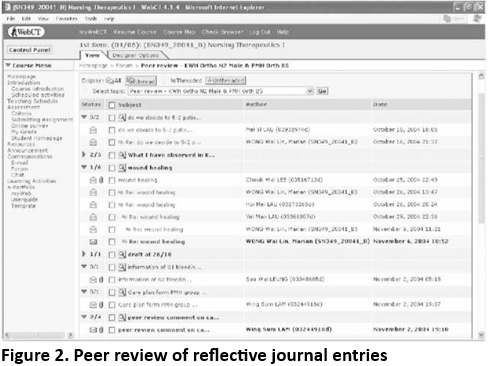
Instructors
 المؤلف:
Paul Lam & Paula Hodgson & Josephine Csete
المؤلف:
Paul Lam & Paula Hodgson & Josephine Csete
 المصدر:
Enhancing Teaching and Learning through Assessment
المصدر:
Enhancing Teaching and Learning through Assessment
 الجزء والصفحة:
P398-C33
الجزء والصفحة:
P398-C33
 2025-08-11
2025-08-11
 402
402
Instructors
As noted earlier, the interaction with peers category was least often found in the present study. The authors hypothesize the relatively small number of assessment activities in this category may be due in part to two reasons. First, the cases reviewed were all in "hybrid" or "blended" courses in which the teacher could also interact with students in regularly scheduled face-to face sessions. In fact, some teachers directly expressed the opinion that as they saw students in class sessions, they were searching for different forms of interaction that students could experience outside of the classroom. Second, this is a comparatively newer category and the methods and prevalence of use in online modes are just emerging. The following two exemplars indicate possible uses in this newer area.
By providing the opportunity for teacher-student interaction on assessment, a staged process for assignments allows for online assignment submission with display of teacher comments. A teacher of a nursing subject asked her students (in groups) to post up their presentations, which could be in the form of PowerPoint presentation slides, video shows, booklets or web pages. All the productions were showcased to the whole class on a website and compiled as a "cybernetic show". The teacher believed that the task would enhance the students' interest and understanding of the issue through creative work. The "cybernetic show" comprised three sections - understanding, exercising and caring in community nursing. Students' projects were collected and displayed in the corresponding sections of the website (Figure 1). Each student group was assigned to any one of the three sections. In this case, the teacher provided her comments and discussed the pros and cons of each student project online The transparent communication between teacher and project groups enabled students to have a better understanding of the expectations of the teacher. In addition, the just-in-time comments allowed students to revisit and further improve their work.

The possibility of teachers commenting on the performance and content of students' online discussion (including activities such as forum discussions and debates) makes teacher-student interaction rich. While real-time debate can help students to develop sharp critical thinking and requires good preparation, online debate allows students more time to reflect and collect further evidence for their arguments in a Web-based environment. The assessment of a higher diploma course in home care for nurses required the part-time students to participate in an online debate as part of the assessment. Student groups took sides on controversial issues that the teacher had prepared detailed information about for debates, with both group and individual contributions (seven altogether). Students posted their views either for or against the idea by set deadlines and according to the specifications in the debate guidelines. The debate assessment had a component of student-student interactions, but its main feature was the strong student-teacher interaction, because the teacher monitored the whole process very closely. In addition to the students' group contributions, the teacher made comments on points that students made in the forum, as well as conclusive judgmental remarks on group performance towards the end of the debate exercise.
 الاكثر قراءة في Teaching Strategies
الاكثر قراءة في Teaching Strategies
 اخر الاخبار
اخر الاخبار
اخبار العتبة العباسية المقدسة


